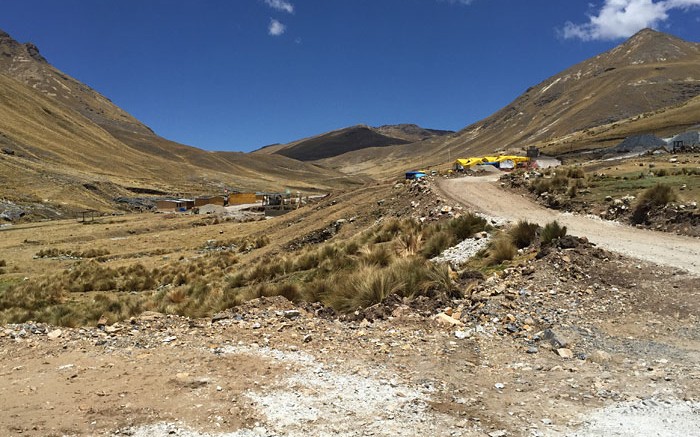Dynacor Gold Mines (TSX: DNG; US-OTC: DNGDF) has discovered a 1.7 km long copper porphyry at its Tumipampa project in the Peruvian Andes that it says could be one of the feeder systems for the gold and copper it has found on the property, 500 km southeast of Lima.
The remote exploration project, 4,500 metres above sea level on a barren plateau, is situated at the contact between the Apurimac batholith — a geological structure where big copper porphyry skarns have been found — and a gold-silver belt to the south, where there are a number of gold mines.
The prospective area has attracted mining companies that include MMG Ltd., with its Las Bambas project to the east; Southern Copper (NYSE: SCCO), with its Los Chancas project, and Iamgold (TSX: IMG; NYSE: IAG), with its Maria project to the west; and Barrick Gold, with its (TSX: ABX; NYSE: ABX) Lily project to the south.
North and northeast are Minas Buenaventura’s (NYSE: BVN) Orcopampa mine; Hochschild Mining’s (LSE: HOC; US-OTC: HCHDF) Arcata and Pallancata projects; Hudbay Minerals’ (TSX: HBM; NYSE: HBM) Constancia mine; First Quantum Minerals’ (TSX: FM) Haquira project; and Bear Creek Mining’s (TSXV: BCM) Layeuga project.
“We are in this porphyry skarn belt in the southern part of Peru — right in the middle of it — so we are well situated here,” Dynacor’s Montreal-based president and CEO Jean Martineau says. “This porphyry is 2.3 km west of mantos and veins where we are exploring, and our geologist thinks that it may be the source of mineralization.”
The French-Canadian mining executive is quick to add that while it is just a theory, it would mean “a new exploration play there — it’s completely different, it’s much bigger than what we thought, and as we have always said, we get good surprises each year we explore there.”
The company will explore the vein area trending west towards the porphyry, and also look for mineralized structures, he says.
News of the discovery released on Nov. 10 include results from surface samples. Of these, 25 taken directly on outcrops of the porphyry show copper grades ranging from 0.01% copper to 0.22% copper, and 14 surface samples returned gold grades ranging from 0.10 gram gold per tonne to 2.51 grams gold per tonne.
Samples collected on a skarn inside the porphyry returned values as high as 40.4 grams silver, 0.44% copper, 108 parts per million molybdenum, 0.99% lead and 2.26% zinc.
Meanwhile, sampling continues at the project’s main Manto Dorado, where Dynacor is finding high-grade mineralization.
In October, Dynacor announced that a raise excavated in Manto Dorado exposed a high-grade, gold-bearing band of sulphides in channel samples. Of the 35 metres excavated, the gold grade averaged 27.3 grams gold, and the copper grade averaged 2.19%.
The results included 12 channel samples with uncut gold assays between 31.1 grams gold and 76.2 grams gold, and 15 channel samples with uncut copper assays between 2% and 8.7%.
Early next year the company plans to undertake a 1,500-tonne bulk sample from Tumipampa and process at its Huanca plant, about 18 hours by road from the project, and 450 km south of Lima. Martineau also expects to finish a technical report on the project in the spring.
Looking ahead, Martineau says the Huanca mill could be used for the first couple of years that Tumipampa is in commercial production, if the grades continue as they are now, at half an ounce per tonne. “The Huanca mill has a capacity of 200 to 300 tonnes per day, so if we could do that for a couple of years and continue exploration at Tumipampa, the operation could pay for itself. In the long-term we will have to build a mill on the property at Tumipampa, but the Huanca mill will give us flexibility … it will be a good test mill, and is a wonderful tool for us.”
Dynacor has built more than half of a second mill near the city of Chala, 600 km south of Lima. The $12.9-million plant is being built with cash flow from the Huanca mill, which processes ore from artisanal miners.
At first the Chala mill will operate at 300 tonnes per day, but it has been designed so that it can be upgraded to 450 and then 600 tonnes per day, as demand warrants. Martineau says construction should be finished by the end of February 2016, with commercial production before mid-2016.
“We built this business model of processing ore from artisanal miners to pay for exploration, weather depressed markets, and generate cash and profit, even if the gold price is depressed,” Martineau says.
In the second quarter, the company posted gold production of 16,594 oz., net income of US$0.8 million, or US2¢ per share, and a 16.8% gross operating margin.


Be the first to comment on "Dynacor finds porphyry at Tumipampa in Peru"